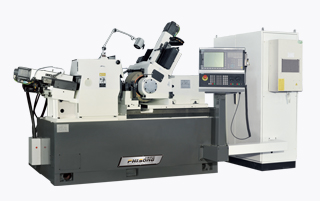

Dynamics
What are the three grinding methods of the centerless grinder: pass through, cut in, and cut in
Release time:2020-12-07
Centerless grinding machine is a type of grinding machine that does not require the use of the axis of the workpiece for grinding. It consists of three mechanisms: grinding wheel, adjusting wheel, and workpiece support. There are three main grinding methods for centerless cylindrical grinders: pass through, cut in, and cut in through.
Through type centerless grinder: The workpiece is fed along the axis direction of the grinding wheel for grinding, and the small inclination angle of the guide wheel axis is adjusted to achieve axial feed of the workpiece. It is suitable for grinding slender cylindrical workpieces, short shafts without center holes, and sleeve type workpieces. In type centerless grinder: There is an axial positioning fulcrum on the support plate, and the workpiece is supported at a certain position on the support plate. The grinding wheel or guide wheel is used to cut in and grind workpieces with shaft shoulders or convex platforms, as well as conical, spherical, or other rotating workpieces. One through centerless grinding is a combination of these two. In addition, there are tangent feed grinding and end face feed grinding that allows stepped workpieces to advance and retreat in the axial direction.
The productivity of the centerless cylindrical grinder is relatively high. Mostly used for mass production and easy to achieve automation.
Compared with ordinary cylindrical grinders, the performance of the centerless cylindrical grinder mechanism has the following characteristics:
1. Continuous processing, no need for tool return, short replication time for workpiece clamping, and high productivity.
2. The positioning mechanism of the bracket and guide wheel has better support rigidity than the top and center frame mechanisms of ordinary cylindrical grinders, with a larger cutting amount, and is conducive to the processing of slender shaft workpieces, making it easy to achieve high-speed grinding and strong grinding.
3. The workpiece of the centerless cylindrical grinder is positioned on the positioning mechanism by the outer circle, and the grinding amount is the margin on the diameter of the workpiece. Therefore, the wear of the grinding wheel, the compensation of the feed mechanism, and the repeated positioning accuracy error of the cutting mechanism have only half of the impact on the diameter and size accuracy of the part compared to ordinary cylindrical grinders, and do not require a center hole, making it easy to automate loading and unloading in advance.
4. The wide grinding wheel centerless grinder has a pass through mechanism that can increase the machining allowance each time. When cutting in, it can perform sequential shape grinding or multi wheel grinding on complex surfaces, with high productivity and wide applicability
The centerless cylindrical grinder does not have a mechanism to ensure the relative positional accuracy (coaxiality, perpendicularity, etc.) between the ground surface and the non ground surface, resulting in poor roundness when grinding circumferential discontinuous outer surfaces. five
6. Grinding surfaces can easily produce odd numbered edge roundness, and when it is large, it often creates the illusion that the measured size is smaller than the maximum physical size, which affects assembly quality and work performance.
7. The adjustment of the centerless grinder is complex and time-consuming, requiring the adjustment of the bracket height, distance, and related process parameters for each replacement of workpieces with different diameters. Therefore, adjusting the technology is difficult and not suitable for small batch and single piece production.
